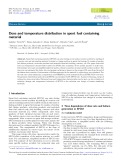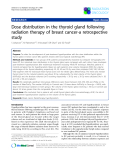
Dose distribution
-
Jiaogulan (Gynostemma pentaphyllum (Thunb.) Makino) is distributed mostly in mountainous areas, in shaded and humid places at 300-3200 meters above sea level. This study was conducted to determine the appropriate application dose of nitrogen for the growth of Jiaogulan under different shading conditions.
 11p
11p  vibecca
vibecca
 01-10-2024
01-10-2024
 2
2
 1
1
 Download
Download
-
The purpose of the study is to quantify breast dose to reassure patients and staff that these understandings still apply. A combination of measurements and simulations were used to estimate absorbed breast dose. Gafchromic® XR-QA2 film was used to measure breast dose placed inside the RANDO® phantom in a series of controlled experiments. The RANDO® is an anthropomorphic phantom commonly used for dosimetry investigations. Gafchromic® XR QA2 film is a radiochromic film that changes colour when irradiated. Simulation is commonly used and readily available.
 195p
195p  runthenight05
runthenight05
 01-03-2023
01-03-2023
 10
10
 3
3
 Download
Download
-
The paper deals with dose and temperature characteristics inside the SFCM after transition of the molten mixture to solid state. Calculations were made on simplified spherical models, without connection to some specific nuclear accident.
 6p
6p  christabelhuynh
christabelhuynh
 30-05-2020
30-05-2020
 18
18
 3
3
 Download
Download
-
Tuyển tập các báo cáo nghiên cứu về y học được đăng trên tạp chí y học Radiation Oncology cung cấp cho các bạn kiến thức về ngành y đề tài: Dose distribution in the thyroid gland following radiation therapy of breast cancer-a retrospective study...
 7p
7p  toshiba10
toshiba10
 14-10-2011
14-10-2011
 49
49
 5
5
 Download
Download
-
Tuyển tập các báo cáo nghiên cứu về y học được đăng trên tạp chí y học Radiation Oncology cung cấp cho các bạn kiến thức về ngành y đề tài: Biological in-vivo measurement of dose distribution in patients’ lymphocytes by gamma-H2AX immunofluorescence staining: 3D conformal- vs. step-and-shoot IMRT of the prostate gland...
 8p
8p  toshiba10
toshiba10
 14-10-2011
14-10-2011
 52
52
 3
3
 Download
Download
-
Understand the quantitative relationship between toxicant exposure and induced effects. • Describe frequently encountered toxic effects. • Interpret frequency (normal distribution) and dose response curves. • Understand threshold effects with dosage increase.
 7p
7p  nguyenvanquan037
nguyenvanquan037
 07-01-2011
07-01-2011
 74
74
 6
6
 Download
Download
















